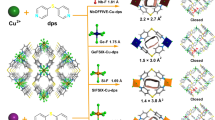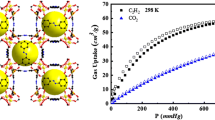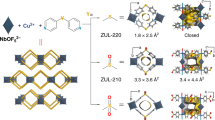Abstract
Multiple space from the interior of metal-organic polyhedra (MOPs), the exterior among MOPs, and the inherent nature of big organic molecules makes MOPs as promising platform with hierarchical porous structures, especially when well-elucidated reticular chemistry principles were used. Herein we describe the preparation of a series of isoreticular octahedral MOPs featuring Zn4-p-tert-butylsulfonylcalix[4]arene clusters by the metal-directed assembly of three rigid organic ligands with different lengths. Intercage hydrogen-bonds and hydrophobic interactions between sulfonylcalix[4]arene groups direct the stacking of discrete MOPs into a novel permanent hierarchical porous material. More importantly, the optimal MOP 1-Zn exhibits high adsorption capacity of Xe and excellent Xe/Kr (20/80, v/v) separation performance, as demonstrated by adsorption isotherms, breakthrough experiments, and density functional theory calculations. Additionally, grand canonical Monte Carlo (GCMC) and dispersion-corrected density functional theory (DFT-D) theoretical calculations provide molecular-level insight over the adsorption/separation mechanism.

Similar content being viewed by others
References
Marshall, J.; Bird, A. C. A comparative histopathological study of argon and krypton laser irradiations of the human retina. Br. J. Ophthalmol. 1979, 63, 657–668.
Lane, G. A.; Nahrwold, M. L.; Tait, A. R.; Taylor-Busch, M.; Cohen, P. J.; Beaudoin, A. R. Anesthetics as teratogens: Nitrous oxide is fetotoxic, xenon is not. Science 1980, 210, 899–901.
Chen, F. Q.; Ding, J. Q.; Guo, K. Q.; Yang, L.; Zhang, Z. G.; Yang, Q. W.; Yang, Y. W.; Bao, Z. B.; He, Y.; Ren, Q. L. CoNi alloy nanoparticles embedded in metal-organic framework-derived carbon for the highly efficient separation of xenon and krypton via a chargetransfer effect. Angew. Chem., Int. Ed. 2021, 60, 2431–2438.
Nandanwar, S. U.; Coldsnow, K.; Utgikar, V.; Sabharwall, P.; Aston, D. E. Capture of harmful radioactive contaminants from off-gas stream using porous solid sorbents for clean environment-A review. Chem. Eng. J. 2016, 306, 369–381.
Soelberg, N. R.; Garn, T. G.; Greenhalgh, M. R.; Law, J. D.; Jubin, R.; Strachan, D. M.; Thallapally, P. K. Radioactive iodine and krypton control for nuclear fuel reprocessing facilities. Sci. Technol. Nucl. Install. 2013, 2013, 702496.
Zhang, H. P.; Fan, Y. L.; Krishna, R.; Feng, X. F.; Wang, L.; Luo, F. Robust metal-organic framework with multiple traps for trace Xe/Kr separation. Sci. Bull. 2021, 66, 1073–1079.
Chen, L. J.; Reiss, P. S.; Chong, S. Y.; Holden, D.; Jelfs, K. E.; Hasell, T.; Little, M. A.; Kewley, A.; Briggs, M. E.; Stephenson, A. et al. Separation of rare gases and chiral molecules by selective binding in porous organic cages. Nat. Mater. 2014, 13, 954–960.
Li, J. R.; Yu, J. M.; Lu, W. G.; Sun, L. B.; Sculley, J.; Balbuena, P. B.; Zhou, H. C. Porous materials with pre-designed single-molecule traps for CO2 selective adsorption. Nat. Commun. 2013, 4, 1538.
Tan, C. X.; Jiao, J. J.; Li, Z. J.; Liu, Y.; Han, X.; Cui, Y. Design and assembly of a chiral metallosalen-based octahedral coordination cage for supramolecular asymmetric catalysis. Angew. Chem., Int. Ed. 2018, 57, 2085–2090.
Wu, K.; Li, K.; Chen, S.; Hou, Y. J.; Lu, Y. L.; Wang, J. S.; Wei, M. J.; Pan, M.; Su, C. Y. The redox coupling effect in a photocatalytic RuII-PdII cage with TTF guest as electron relay mediator for visible-light hydrogen-evolving promotion. Angew. Chem., Int. Ed. 2020, 59, 2639–2643.
Gosselin, A. J.; Rowland, C. A.; Bloch, E. D. Permanently microporous metal-organic polyhedral. Chem. Rev. 2020, 120, 8987–9014.
Zhu, Z. Z.; Tian, C. B.; Sun, Q. F. Coordination-assembled molecular cages with metal cluster nodes. Chem. Rec. 2021, 21, 498–522.
Grancha, T.; Carné-Sánchez, A.; Hernández-López, L.; Albalad, J.; Imaz, I.; Juanhuix, J.; Maspoch, D. Phase transfer of rhodium(II)-based metal-organic polyhedra bearing coordinatively bound cargo enables molecular separation. J. Am. Chem. Soc. 2019, 141, 18349–18355.
Diercks, C. S.; Yaghi, O. M. The atom, the molecule, and the covalent organic framework. Science 2017, 355, eaal1585.
Pan, M.; Liao, W. M.; Yin, S. Y.; Sun, S. S.; Su, C. Y. Single-phase white-light-emitting and photoluminescent color—tuning coordination assemblies. Chem. Rev. 2018, 118, 8889–8935.
Yuan, G. Z.; Jiang, H.; Zhang, L. Y.; Liu, Y.; Cui, Y. Metallosalen-based crystalline porous materials: Synthesis and property. Coord. Chem. Rev. 2019, 378, 483–499.
Lal, G.; Derakhshandeh, M.; Akhtar, F.; Spasyuk, D. M.; Lin, J. B.; Trifkovic, M.; Shimizu, G. K. H. Mechanical properties of a metal-organic framework formed by covalent cross-linking of metal-organic polyhedral. J. Am. Chem. Soc. 2019, 141, 1045–1053.
Bloch, W. M.; Babarao, R.; Schneider, M. L. On/off porosity switching and post-assembly modifications of Cu4L4 metal-organic polyhedral. Chem. Sci. 2020, 11, 3664–3671.
Zhang, D. W.; Ronson, T. K.; Nitschke, J. R. Functional capsules via subcomponent self-assembly. Acc. Chem. Res. 2018, 51, 2423–2436.
Gong, W.; Chu, D. D.; Jiang, H.; Chen, X.; Cui, Y.; Liu, Y. Permanent porous hydrogen-bonded frameworks with two types of Brønsted acid sites for heterogeneous asymmetric catalysis. Nat. Commun. 2019, 10, 600.
Wang, Z.; He, L. Z.; Liu, B. Q.; Zhou, L. P.; Cai, L. X.; Hu, S. J.; Li, X. Z.; Li, Z. K.; Chen, T. F.; Li, X. P. et al. Coordination-assembled water-soluble anionic lanthanide organic polyhedra for luminescent labeling and magnetic resonance imaging. J. Am. Chem. Soc. 2020, 142, 16409–16419.
Wang, L. J.; Li, X.; Bai, S.; Wang, Y. Y.; Han, Y. F. Self-assembly, structural transformation, and guest-binding properties of supramolecular assemblies with triangular metal-metal bonded units. J. Am. Chem. Soc. 2020, 142, 2524–2531.
Chen, S.; Behera, N.; Yang, C.; Dong, Q. B.; Zheng, B. S.; Li, Y. Y.; Tang, Q.; Wang, Z. X.; Wang, Y. Q.; Duan, J. G. A chemically stable nanoporous coordination polymer with fixed and free Cu2+ ions for boosted C2H2/CO2 separation. Nano Res. 2021, 14, 546–553.
Vardhan, H.; Yusubov, M.; Verpoort, F. Self-assembled metal-organic polyhedra: An overview of various applications. Coord. Chem. Rev. 2016, 306, 171–194.
Zhang, X.; Dong, X.; Lu, W. G.; Luo, D.; Zhu, X. W.; Li, X.; Zhou, X. P.; Li, D. Fine-tuning apertures of metal-organic cages: Encapsulation of carbon dioxide in solution and solid state. J. Am. Chem. Soc. 2019, 141, 11621–11627.
Dai, F. R.; Wang, Z. Q. Modular assembly of metal-organic supercontainers incorporating sulfonylcalixarenes. J. Am. Chem. Soc. 2012, 134, 8002–8005.
Bi, Y. F.; Du, S. C.; Liao, W. P. Thiacalixarene-based nanoscale polyhedral coordination cages. Coord. Chem. Rev. 2014, 276, 61–72.
Wang, S. T.; Gao, X. H.; Hang, X. X.; Zhu, X. F.; Han, H. T.; Liao, W. P.; Chen, W. Ultrafine Pt nanoclusters confined in a calixarene-based {Ni24} coordination cage for high-efficient hydrogen evolution reaction. J. Am. Chem. Soc. 2016, 138, 16236–16239.
Liang, Y.; Fang, Y.; Cui, Y.; Zhou, H. C. A stable biocompatible porous coordination cage promotes in vivo liver tumor inhibition. Nano Res. 2021, 14, 3407–3415.
Dai, F. R.; Sambasivam, U.; Hammerstrom, A. J.; Wang, Z. Q. Synthetic supercontainers exhibit distinct solution versus solid state guest-binding behavior. J. Am. Chem. Soc. 2014, 136, 7480–7491.
Hang, X. X.; Liu, B.; Zhu, X. F.; Wang, S. T.; Han, H. T.; Liao, W. P.; Liu, Y. L.; Hu, C. H. Discrete {Ni40} coordination cage: A calixarene-based Johnson-type (J17) hexadecahedron. J. Am. Chem. Soc. 2016, 138, 2969–2972.
Fang, Y.; Xiao, Z. F.; Kirchon, A.; Li, J. L.; Jin, F. Y.; Togo, T.; Zhang, L. L.; Zhu, C. F.; Zhou, H. C. Bimolecular proximity of a ruthenium complex and methylene blue within an anionic porous coordination cage for enhancing photocatalytic activity. Chem. Sci. 2019, 10, 3529–3534.
Han, H. T.; Kan, L.; Li, P.; Zhang, G. S.; Li, K. Y.; Liao, W. P.; Liu, Y. L.; Chen, W.; Hu, C. T. 4. 8 nm concave {M72} (M = Co, Ni, Fe) metal-organic polyhedra capped by 18 calixarenes. Sci. China Chem. 2021, 64, 426–431.
Spek, A. L. Single-crystal structure validation with the program PLATON. J. Appl. Cryst. 2003, 36, 7–13.
Tranchemontagne, D. J.; Ni, Z.; O’Keeffe, M.; Yaghi, O. M. Reticular chemistry of metal-organic polyhedral. Angew. Chem., Int. Ed. 2008, 47, 5136–5147.
Zhang, Y. Y.; Gao, W. X.; Lin, L.; Jin, G. X. Recent advances in the construction and applications of heterometallic macrocycles and cages. Coord. Chem. Rev. 2017, 344, 323–344.
Wang, Y.; Chang, J. P.; Xu, R.; Bai, S.; Wang, D.; Yang, G. P.; Sun, L. Y.; Li, P.; Han, Y. F. N-heterocyclic carbenes and their precursors in functionalised porous materials. Chem. Soc. Rev. 2021, 50, 13559–13586.
Argent, S. P.; da Silva, I.; Greenaway, A.; Savage, M.; Humby, J.; Davies, A. J.; Nowell, H.; Lewis, W.; Manuel, P.; Tang, C. C. et al. Porous metal-organic polyhedra: Morphology, porosity, and guest binding. Inorg. Chem. 2020, 59, 15646–15658.
Liu, G. L.; Zhou, M.; Su, K. Z.; Babarao, R.; Yuan, D. Q.; Hong, M. C. Stabilizing the extrinsic porosity in metal-organic cages-based supramolecular framework by in situ catalytic polymerization. CCS Chem. 2020, 3, 1382–1390.
Dong, Q. B.; Zhang, X.; Liu, S.; Lin, R. B.; Guo, Y. N.; Ma, Y. S.; Yonezu, A.; Krishna, R.; Liu, G. P.; Duan, J. G. et al. Tuning gate-opening of a flexible metal-organic framework for ternary gas sieving separation. Angew. Chem., Int. Ed. 2020, 59, 22756–22762.
Behera, N.; Duan, J. G.; Jin, W. Q.; Kitagawa, S. The chemistry and applications of flexible porous coordination polymers. EnergyChem 2021, 3, 100067.
Zhao, X.; Wang, Y. X.; Li, D. S.; Bu, X. H.; Feng, P. Y. Metal-organic frameworks for separation. Adv. Mater. 2018, 30, 1705189.
Wang, J. Z.; Fu, X. P.; Liu, Q. Y.; Chen, L.; Xu, L. P.; Wang, Y. L. Dinuclear nickel-oxygen cluster-based metal-organic frameworks with octahedral cages for efficient Xe/Kr separation. Inorg. Chem. 2022, 61, 5737–5743.
Lee, S. J.; Kim, K. C.; Yoon, T. U.; Kim, M. B.; Bae, Y. S. Selective dynamic separation of Xe and Kr in Co-MOF-74 through strong binding strength between Xe atom and unsaturated Co2+ site. Micropor. Mesopor. Mater. 2016, 236, 284–291.
Niu, Z.; Fan, Z. W.; Pham, T.; Verma, G.; Forrest, K. A.; Space, B.; Thallapally, P. K.; Al-Enizi, A. M.; Ma, S. Q. Self-adjusting metal-organic framework for efficient capture of trace xenon and krypton. Angew. Chem., Int. Ed. 2022, 61, e202117807.
Wang, H.; Yao, K. X.; Zhang, Z. J.; Jagiello, J.; Gong, Q. H.; Han, Y.; Li, J. The first example of commensurate adsorption of atomic gas in a MOF and effective separation of xenon from other noble gases. Chem. Sci. 2014, 5, 620–624.
Chen, X. Y.; Plonka, A. M.; Banerjee, D.; Krishna, R.; Schaef, H. T.; Ghose, S.; Thallapally, P. K.; Parise, J. B. Direct observation of Xe and Kr adsorption in a Xe-selective microporous metal-organic framework. J. Am. Chem. Soc. 2015, 137, 7007–7010.
Mohamed, M. H.; Elsaidi, S. K.; Pham, T.; Forrest, K. A.; Schaef, H. T.; Hogan, A.; Wojtas, L.; Xu, W. Q.; Space, B.; Zaworotko, M. J. et al. Hybrid ultra-microporous materials for selective xenon adsorption and separation. Angew. Chem., Int. Ed. 2016, 55, 8285–8289.
Li, L. Y.; Guo, L. D.; Zhang, Z. G.; Yang, Q. W.; Yang, Y. W.; Bao, Z. B.; Ren, Q. L.; Li, J. A robust squarate-based metal-organic framework demonstrates record-high affinity and selectivity for xenon over krypton. J. Am. Chem. Soc. 2019, 141, 9358–9364.
Bae, Y. S.; Hauser, B. G.; Colón, Y. J.; Hupp, J. T.; Farha, O. K.; Snurr, R. Q. High xenon/krypton selectivity in a metal-organic framework with small pores and strong adsorption sites. Micropor. Mesopor. Mater. 2013, 169, 176–179.
Lee, S. J.; Yoon, T. U.; Kim, A. R.; Kim, S. Y.; Cho, K. H.; Hwang, Y. K.; Yeon, J. W.; Bae, Y. S. Adsorptive separation of xenon/krypton mixtures using a zirconium-based metal-organic framework with high hydrothermal and radioactive stabilities. J. Hazard. Mater. 2016, 320, 513–520.
Fu, X. P.; Li, Z. R.; Liu, Q. Y.; Guan, H. X.; Wang, Y. L. Microporous metal-organic framework with cage-within-cage structures for xenon/krypton separation. Ind. Eng. Chem. Res. 2022, 61, 7397–7402.
Banerjee, D.; Simon, C. M.; Plonka, A. M.; Motkuri, R. K.; Liu, J.; Chen, X. Y.; Smit, B.; Parise, J. B.; Haranczyk, M.; Thallapally, P. K. Metal-organic framework with optimally selective xenon adsorption and separation. Nat. Commun. 2016, 7, ncomms11831.
Li, J. L.; Huang, L.; Zou, X. Q.; Zheng, A. M.; Li, H. Y.; Rong, H. Z.; Zhu, G. S. Porous organic materials with ultra-small pores and sulfonic functionality for xenon capture with exceptional selectivity. J. Mater. Chem. A 2018, 6, 11163–11168.
Acknowledgements
This work was supported by the National Natural Science Foundation of China (No. 22101004), the Natural Science Foundation of Anhui Province (No. 2008085QB62), and the Shanghai Science and Technology Committee (No. 19DZ2270100).
Author information
Authors and Affiliations
Corresponding authors
Electronic Supplementary Material
Rights and permissions
About this article
Cite this article
Shan, WL., Xu, ML., Hou, HH. et al. Sulfonylcalix[4]arene-based metal-organic polyhedra with hierarchical porous structures for efficient Xe/Kr separation. Nano Res. 16, 2536–2542 (2023). https://doi.org/10.1007/s12274-022-4909-y
Received:
Revised:
Accepted:
Published:
Issue Date:
DOI: https://doi.org/10.1007/s12274-022-4909-y




